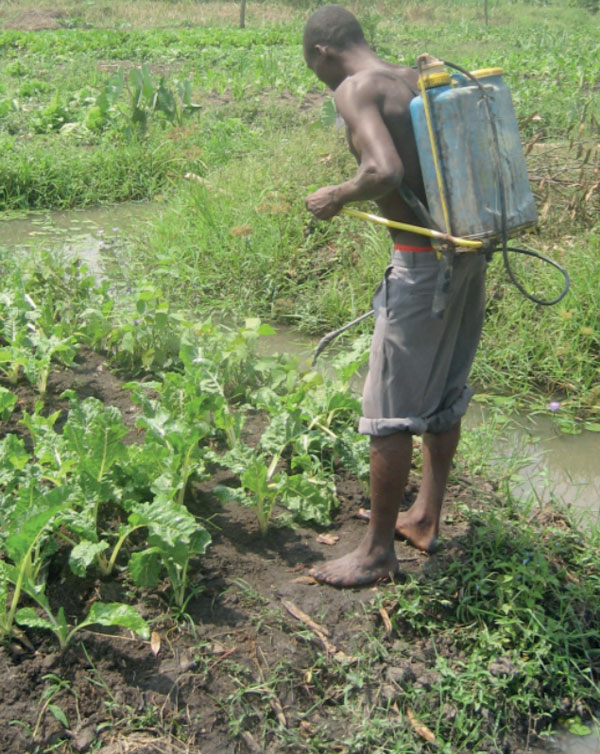
Kampala, Uganda | THE INDEPENDENT | Up to eight harmful pesticide contaminants have been found in tomatoes sold in major markets in Kampala and other parts of Uganda.
The study by the Uganda National Association of Community and Occupational Health – UNACOH was done in 18 districts of Uganda under its Pesticide Use, Health and Environment Project implemented in collaboration with Diálogos, a Danish voluntary organization working to promote health in poor countries
The study was conducted in the four geographical regions of Uganda, covering the districts of Kampala, Sembabule, Wakiso, Kayunga, Rakai, Bushenyi, Ntungamo, Kamwenge, Masindi, Nebbi, Adjumani, Kitgum, Gulu, Kapchorwa, Kumi, Pallisa, Budaka and Bugiri.
Across the areas, tomatoes were randomly bought from market vendors and farms for analysis for the presence of pesticide residues in the Directorate of Government Analytical Laboratory (DGAL).
Contamination highest end of June
Dr Deogratious Ssekimpi, the Executive Director of Uganda National Association of Community and Occupational Health-UNACOH, says the scientific analysis found that the number of tomatoes contaminated with the harmful pesticide residues gets worse at the end of June as the first cropping season March – June planting season comes to an end.
Dr Ssekimpi said that the vendors in the sampled markets prefer to sell tomatoes containing visible pesticide residues to consumers saying the contaminants especially Mancozeb increase the shelf life of the tomatoes by hardening its outer skin.
“Some farmers told us they spray their crops even on the day they are going to sell in order to make their crops attractive. And some consumers who know very well that the pesticide residues are harmful to their health still buy the contaminated tomatoes because of lack of alternatives” he stated.
Dr Ssekimpi says that the study also observed a worrying trend of Community water source pollution with harmful pesticide residues. He says that for water sources; the number of contaminations increases from seven in April to more than 23 different contaminants at the end of June.
Aggrey Atuhaire, the Coordinator of Pesticide Use, Health and Environment Project at UNACOH says they collected water samples from 86 water sources in the districts where the research was conducted, and established that up to 94 per cent of them had one detectable concentration of a pesticide residue at the beginning of April and end of June.
The scientists say that the contamination into water sources emanates from poorly disposed of pesticide containers, farmers spraying near water sources or washing their sprayers inside community water sources. They also found out that sometimes, the contaminants are washed into sources by rainwater.
Of even greater concern is that some of the farmers spray without protective gear even in the presence of Children. Atuhaire adds that the contaminations in tomatoes are scary when compared to recommended international standards for human uptake and the environment.

any personal protective equipment. PHOTO AFRICAN NEWSLETTER
Peel and wash in warm water
Atuhaire says the first line of defence against harmful pesticide contamination is preventing contamination by peeling the outer skin of the tomatoes and washing in warm water instead of cold water.
The project also undertook studies to establish pesticide poisoning levels from home and related registration in health centres where victims are taken for treatment.
It was established that farmers poorly store their agro chemicals around food and in places accessible to children.
“We saw that children are accidentally poisoned while adults unintentionally use the chemicals for committing suicides. Unfortunately, the current Ministry of Health Data Capture system does not clearly capture acute pesticide poisoning as a major community health concern” says Occupational Health Specialist Victoria Nabankema.
Professor Erik Joers, a Clinical Expert of Occupational Medicine in the University of Southern Denmark says there are multiple risks associated to the use of such chemicals including fertility problems, respiratory problems, affecting the development of the fetus during pregnancy and development of diseases such as cancer among others.
High misuse of agro-chemicals
John Mwanje, the Acting Commissioner for Agro Chemicals at the Ministry of Agriculture, Animal Industry and Fisheries (MAAIF) says there is a global concern over the increase in cases of Cancer-causing Human Papilloma Virus (HPV) associated with misuse of agro-chemicals around the World. He says the new study has made critical findings for MAIIF to strengthen its regulation.
“We have available data on agrochemical use in Uganda. We know that some of the Chemicals are fake entering the country through illicit pathways at porous borders while others are genuine. We would like to use extension workers to sensitize people on the dangers of misusing insecticides, rodenticides and other agrochemicals” he stated.
The Volume of pesticides imported into Uganda has sharply risen in recent years as Climate Change pound the country, with the emergence of Fall Army Worms exacerbating the problem. Available data indicates that importation of pesticides into Uganda is on a significant rise.
The scientists say that unless regulated fast enough, the problem of misuse of pesticides is a ticking time bomb for the country.
******
URN
 The Independent Uganda: You get the Truth we Pay the Price
The Independent Uganda: You get the Truth we Pay the Price



What do you advise government /the population? we hear organic fertilizers,where are they?yes they are here but there has to be a lot of sensitization.
Hello
I am aware that in Uganda, the private organizations involved in food manufacture and export have food safety standards that address the needs and requirements of their recipient countries. Does Uganda as a nation have a national food safety standard that cover every food consumer across the nation? If so, how effective is it? If not, what are some of the strategies in place? and what planned are there to protect the local consumer health?